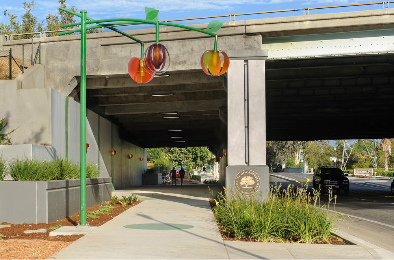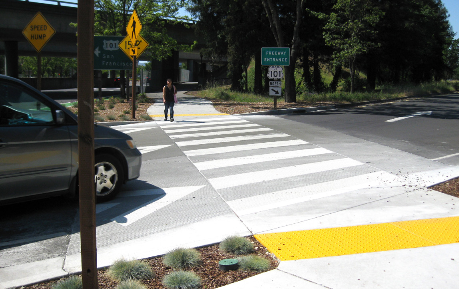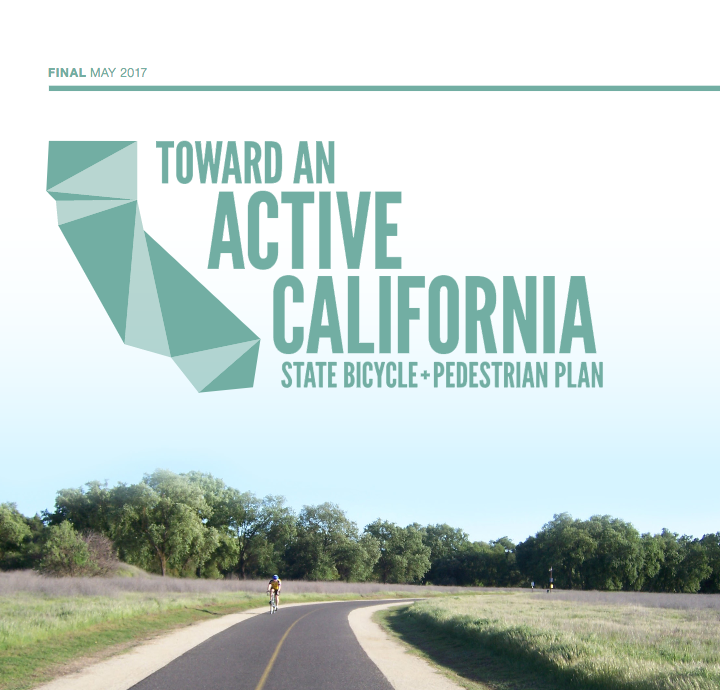Caltrans released the final draft of its first-ever statewide bike and pedestrian plan today. Toward an Active California outlines the policies and measures that the state can take to help reach its goals of increasing bicycling and walking in California while reducing fatalities among bike riders and people walking.
The plan acknowledges that Caltrans can't reach its ambitious goals alone, and needs help from local partners. But while the department does not have jurisdiction over local transportation planning or policies, it does wield considerable influence over infrastructure decisions made at the local level. Caltrans also provides expertise and guidance when local departments are understaffed or need assistance, so a statewide plan that provides a cohesive vision for safe, comfortable biking and walking in California communities is an important first step towards making that happen.
The plan's stated vision is that “by 2040, people in California of all ages, abilities, and incomes can safely, conveniently, and comfortably walk and bicycle for their transportation needs.”
Let that sink in for a minute.
Caltrans' stated goal is to make walking and bicycling so safe and comfortable that anyone could choose to walk or bike for at least some of their trips. That would be a dramatic change for California communities. It is also a huge leap forward from previous state transportation planning that reluctantly accounted for “nonmotorized travel” because there were all those darn people out there walking and biking.
“The plan is really good,” said Dave Snyder, Executive Director of CalBike. “In theory. But the big question is whether Caltrans can turn it into practice.”

The bike and pedestrian plan, according to Caltrans, is the product of a year-and-a-half-long effort between the department, local and regional agencies, state agency partners, pedestrian and bicycle advocacy organizations, and the public. It is designed to complement local and regional active transportation plans that are now at various stages of development throughout California.
It is written as a guide to planning and developing infrastructure for people who don't use cars, and, importantly, to guide future investments in the state highway system. It is also aimed at improving bike and pedestrian connections among local and regional roads, public transit, and intercity and passenger rail.
Its four overarching objectives are safety, increasing walking and bicycling mode shares, maintaining high quality infrastructure, and investing in communities that are most dependent on active transportation and transit. From there, the plan includes strategies aimed at achieving targets from the Caltrans Strategic Management Plan, specifically to double the number of trips made by walking, triple the number of trips made by bike, and double transit use--all by 2020--as well as reduce bicycle and pedestrian fatalities by ten percent per year. The plan also has a goal to increase the number of complete streets projects in California by twenty percent.
All of this should be helped by the recent passage of S.B. 1, which will bring an influx of cash for repairing and maintaining roads. That will include improvements that make it safer for bicyclists and pedestrians. S.B. 1 will also greatly increase funding for the Active Transportation Program, which has been the subject of much discussion and improvement over the last few years and may finally have enough money to begin to bring some of the changes promised by this plan.
Snyder is pleased with the way Caltrans staff took feedback it received seriously. For example, in the first drafts there were few meaningful performance measures, but after comments came in, staff added short-term and long-term goals with timelines.
“They got the right priorities, and they put them first in the plan,” he said. “Some of the most important ones are in the short-term category, to be completed within two to four years,” said Snyder. “For example, developing a new design manual for bikeways--that's going to be huge for local planners. Another short-term goal is investing more in communities to build out complete networks.”
But how much money to invest, or how many complete networks need to be built, is not spelled out. And even with the timeline, not all the goals are SMART goals (that is, specific, measurable, achievable, relevant, and time-bound). “They're not necessarily specific or measurable,” said Snyder, “and where they are specific, they're not measurable.”
“It will be up to us as advocates to make sure they take those short term goals seriously, and implement them in a robust fashion,” said Snyder. “Our job as the bicycle coalition is to come back to this plan a year or six months from now and identify any progress they're making, and hold them accountable,” he said.
“And if they make real progress, this is a big deal,” he said.
Important and innovative ideas in the plan include: creating a universal elementary school curriculum on safely traveling by bike and foot; improving data collection on collisions and near-misses, and getting a better idea how many bikers and pedestrians are out there now; training for police and diversion programs for ticketed bicyclists; setting lower speed limits; training transportation planners to think about complete networks, and investing in them; and more.

The plan is also full of photos of examples of good infrastructure that can inspire and guide planning decisions. These include photos of a raised crosswalk in Windsor, a widened, landscaped highway undercrossing in Campbell, buffered green bike lanes in San Mateo, colored shoulder lanes on Highway 1, bike boxes in Tiburon, bike highways in Holland, and bike parking at L.A. Metro.
If this plan succeeds, there will soon be more examples from California to add to this list.






